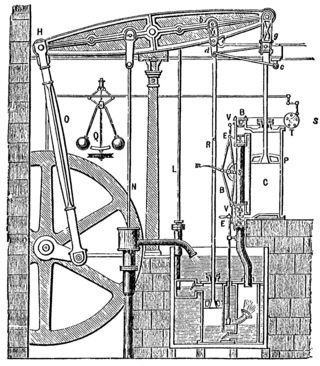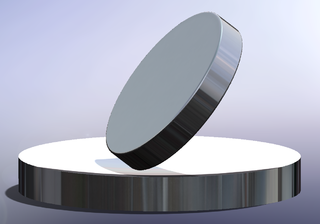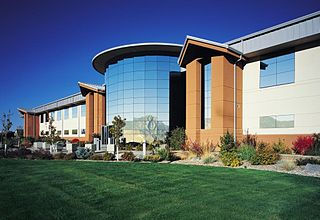
In physics, angular momentum is the rotational analog of linear momentum. It is an important physical quantity because it is a conserved quantity – the total angular momentum of a closed system remains constant. Angular momentum has both a direction and a magnitude, and both are conserved. Bicycles and motorcycles, flying discs, rifled bullets, and gyroscopes owe their useful properties to conservation of angular momentum. Conservation of angular momentum is also why hurricanes form spirals and neutron stars have high rotational rates. In general, conservation limits the possible motion of a system, but it does not uniquely determine it.

An electric motor is an electrical machine that converts electrical energy into mechanical energy. Most electric motors operate through the interaction between the motor's magnetic field and electric current in a wire winding to generate force in the form of torque applied on the motor's shaft. An electric generator is mechanically identical to an electric motor, but operates in reverse, converting mechanical energy into electrical energy.
H∞methods are used in control theory to synthesize controllers to achieve stabilization with guaranteed performance. To use H∞ methods, a control designer expresses the control problem as a mathematical optimization problem and then finds the controller that solves this optimization. H∞ techniques have the advantage over classical control techniques in that H∞ techniques are readily applicable to problems involving multivariate systems with cross-coupling between channels; disadvantages of H∞ techniques include the level of mathematical understanding needed to apply them successfully and the need for a reasonably good model of the system to be controlled. It is important to keep in mind that the resulting controller is only optimal with respect to the prescribed cost function and does not necessarily represent the best controller in terms of the usual performance measures used to evaluate controllers such as settling time, energy expended, etc. Also, non-linear constraints such as saturation are generally not well-handled. These methods were introduced into control theory in the late 1970s-early 1980s by George Zames, J. William Helton , and Allen Tannenbaum.

Centrifugal compressors, sometimes called impeller compressors or radial compressors, are a sub-class of dynamic axisymmetric work-absorbing turbomachinery.

In the physical science of dynamics, rigid-body dynamics studies the movement of systems of interconnected bodies under the action of external forces. The assumption that the bodies are rigid simplifies analysis, by reducing the parameters that describe the configuration of the system to the translation and rotation of reference frames attached to each body. This excludes bodies that display fluid, highly elastic, and plastic behavior.

Euler's Disk, invented between 1987 and 1990 by Joseph Bendik, is a trademarked scientific educational toy. It is used to illustrate and study the dynamic system of a spinning and rolling disk on a flat or curved surface. It has been the subject of several scientific papers.
Dynamical simulation, in computational physics, is the simulation of systems of objects that are free to move, usually in three dimensions according to Newton's laws of dynamics, or approximations thereof. Dynamical simulation is used in computer animation to assist animators to produce realistic motion, in industrial design, and in video games. Body movement is calculated using time integration methods.
In rotordynamics, the rigid rotor is a mechanical model of rotating systems. An arbitrary rigid rotor is a 3-dimensional rigid object, such as a top. To orient such an object in space requires three angles, known as Euler angles. A special rigid rotor is the linear rotor requiring only two angles to describe, for example of a diatomic molecule. More general molecules are 3-dimensional, such as water, ammonia, or methane.
In classical mechanics, the Newton–Euler equations describe the combined translational and rotational dynamics of a rigid body.

Rotation around a fixed axis or axial rotation is a special case of rotational motion around an axis of rotation fixed, stationary, or static in three-dimensional space. This type of motion excludes the possibility of the instantaneous axis of rotation changing its orientation and cannot describe such phenomena as wobbling or precession. According to Euler's rotation theorem, simultaneous rotation along a number of stationary axes at the same time is impossible; if two rotations are forced at the same time, a new axis of rotation will result.
In solid mechanics, in the field of rotordynamics, the critical speed is the theoretical angular velocity that excites the natural frequency of a rotating object, such as a shaft, propeller, leadscrew, or gear. As the speed of rotation approaches the object's natural frequency, the object begins to resonate, which dramatically increases system vibration. The resulting resonance occurs regardless of orientation. When the rotational speed is equal to the natural frequency, then that speed is referred to as a critical speed.

Bently Nevada is an asset protection and condition monitoring hardware, software and service company for industrial plant-wide operations. Its products are used to monitor the mechanical condition of rotating equipment in a wide variety of industries including oil and gas production, hydroelectric, wind, hydrocarbon processing, electric power generation, pulp and paper, mining, water and wastewater treatment. The company was founded in 1961 by Don Bently. Bently Nevada is headquartered in Minden, Nevada, about one hour south of Reno. Don Bently was the first to manufacture a commercially successful eddy-current proximity probe which measured vibration in high-speed turbomachinery by allowing the direct observation of the rotating shaft. The company also performed research in the field of rotordynamics, furthering knowledge of machinery malfunctions such as shaft cracks and fluid-induced instabilities. Its research also helped refine the equations used to describe vibratory behavior in rotordynamic systems.

Vibration is a mechanical phenomenon whereby oscillations occur about an equilibrium point. Vibration may be deterministic if the oscillations can be characterised precisely, or random if the oscillations can only be analysed statistically.

A Campbell diagram plot represents a system's response spectrum as a function of its oscillation regime. It is named for Wilfred Campbell, who introduced the concept. It is also called an interference diagram.
In physics, nonlinear resonance is the occurrence of resonance in a nonlinear system. In nonlinear resonance the system behaviour – resonance frequencies and modes – depends on the amplitude of the oscillations, while for linear systems this is independent of amplitude. The mixing of modes in non-linear systems is termed resonant interaction.
Rotating unbalance is the uneven distribution of mass around an axis of rotation. A rotating mass, or rotor, is said to be out of balance when its center of mass is out of alignment with the center of rotation. Unbalance causes a moment which gives the rotor a wobbling movement characteristic of vibration of rotating structures.
Transformation of three phase electrical quantities to two phase quantities is a usual practice to simplify analysis of three phase electrical circuits. Polyphase a.c machines can be represented by an equivalent two phase model provided the rotating polyphases winding in rotor and the stationary polyphase windings in stator can be expressed in a fictitious two axes coils. The process of replacing one set of variables to another related set of variable is called winding transformation or simply transformation or linear transformation. The term linear transformation means that the transformation from old to new set of variable and vice versa is governed by linear equations. The equations relating old variables and new variables are called transformation equation and the following general form:
[new Variable] = [transformation matrix][old variable] [old Variable] = [transformation matrix][new variable]
Dynamic Substructuring (DS) is an engineering tool used to model and analyse the dynamics of mechanical systems by means of its components or substructures. Using the dynamic substructuring approach one is able to analyse the dynamic behaviour of substructures separately and to later on calculate the assembled dynamics using coupling procedures. Dynamic substructuring has several advantages over the analysis of the fully assembled system:

Critical embankment velocity or critical speed, in transportation engineering, is the velocity value of the upper moving vehicle that causes the severe vibration of the embankment and the nearby ground. This concept and the prediction method was put forward by scholars in civil engineering communities before 1980 and stressed and exhaustively studied by Krylov in 1994 based on the Green function method and predicted more accurately using other methods in the following. When the vehicles such as high-speed trains or airplanes move approaching or beyond this critical velocity, the vibration magnitudes of vehicles and nearby ground increase rapidly and possibly lead to the damage to the passengers and the neighboring residents. This relevant unexpected phenomenon is called the ground vibration boom from 1997 when it was observed in Sweden for the first time.
Agnieszka Muszyńska (1935–2024) was a Polish-American mechanical engineer specializing in rotordynamics and the vibrations of rotating machinery.













